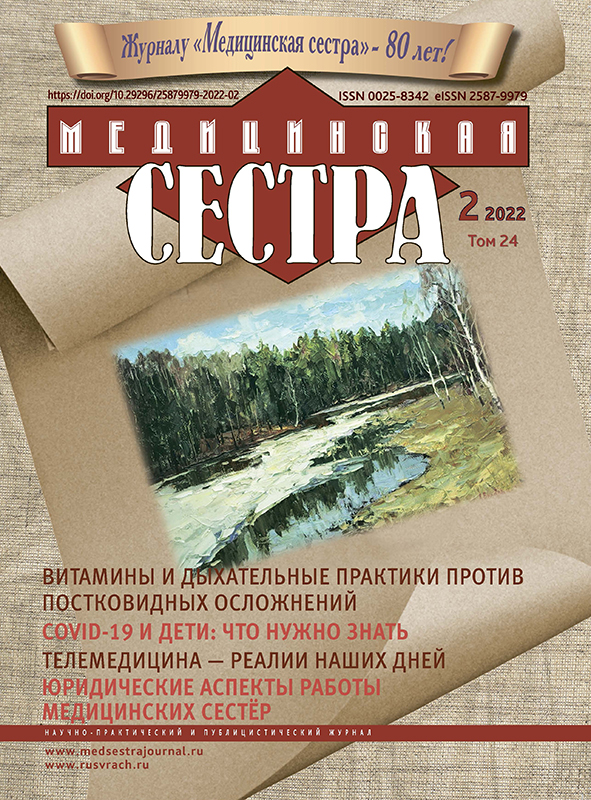Children’s problems of coronavirus infection (discussion of the latest data)
- Authors: Grigoriev K.I.1, Radchenko O.M.2, Shirobokov Y.E.3
-
Affiliations:
- Pirogov Russian National Research Medical University
- Regional Children’s Clinical Hospital № 2, Voronezh
- Samara State Medical University of the Ministry of Health of the Russian Federation
- Issue: Vol 24, No 2 (2022)
- Pages: 35-41
- Section: Articles
- URL: https://journals.eco-vector.com/0025-8342/article/view/113864
- DOI: https://doi.org/10.29296/25879979-2022-02-09
- ID: 113864
Cite item
Abstract
The pandemic of a new severe infection, declared by the World Health Organization last year, continues to develop. To a certain extent, the epidemic has affected the children’s population. Pediatricians for the first time faced with an incredible situation when adults get sick more severely than children. Summary data are presented on the results of clinical observations in the Tushinskaya Children’s City Clinical Hospital in Moscow, and on the results of scientific sources. The article sums up the results of the latest observations regarding the development of a new disease, its diagnosis, therapeutic possibilities using modern medicines. The role of the use of standards is emphasized, in particular, the clinical recommendations of the Ministry of Health of Russia, the 14th version of which has just been posted on the website of the ministry.
Keywords
Full Text
About the authors
Konstantin I. Grigoriev
Pirogov Russian National Research Medical University
Author for correspondence.
Email: k-i-grigoryev@yandex.ru
Doctor of Medicine, Pediatrics with Infectious Diseases in Children Department Professor
Olga M. Radchenko
Regional Children’s Clinical Hospital № 2, Voronezh
Email: k-i-grigoryev@yandex.ru
infectious disease specialist of the 5th department (“red zone”)
Yaroslav E. Shirobokov
Samara State Medical University of the Ministry of Health of the Russian Federation
Email: k-i-grigoryev@yandex.ru
References
- Супотницкий М.В. Пандемия COVID-19 как индикатор «белых пятен» в эпидемиологии и инфекционной патологии. Вестник войск РХБ защиты. 2020. Т. 4. № 3: 338-373 https://doi.org/10.35825/2587-5728-2020-4-3-338-373
- Кудлай Д.А., Широбоков Я.Е., Гладунова Е.П., Бородулина Е.А. Диагностика COVID-19. Способы и проблемы обнаружения вируса SARS-COV-2 в условиях пандемии. Врач. 2020; 31(8): 5-10.
- Gaythorpe K.A. M., Bhatia S., Mangal T., et al. Children’s role in the COVID-19 pandemic: a systematic review of early surveillance data on susceptibility, severity, and transmissibility. Nature. 2021; 11: 13903. https://doi.org/10.1038/s41598-021-92500-9
- Hoffmann M, Kleine-Weber H, Schroeder S, et al. SARS-CoV-2 cell entry depends on ACE2 and TMPRSS2 and is blocked by a clinically proven protease inhibitor. Cell. 2020; 181: 271-280.
- Synowiec A, Szczepanski A, Barreto-Duran E, et al. Severe acute respiratory syndrome coronavirus 2 (SARSCoV-2): a systemic infection. Clin Microbiol Rev. 2021. 34:e00133-20. https://doi.org/10.1128/CMR.00133-20.
- Logunov DY, Dolzhikova IV, Shcheblyakov DV, et al. Safety and efficacy of an rAd26 and rAd5 vector-based heterologous prime-boost COVID-19 vaccine: an interim analysis of a randomised controlled phase 3 trial in Russia. Lancet. 2021; vol. 397, issue 10275: 671-681. https://doi.org/10.1016/S0140-6736(21)00234-8
- Румянцев А.Г. Коронавирусная инфекция COVID-19. Научные вызовы и возможные пути лечения и профилактики заболевания. Российский журнал детской гематологии и онкологии. 2020; 7 (3):47-53. https://doi.org/10.21682/2311-1267-2020-7-3-47-53
- Huang C., Wang Y., Li X., et al. Ginical features of patients infected with the new coronavirus 2019 in Wuhan, China. The Lancet. 2020; 395: 497-506.
- Martin B, DeWitt PE, Russell S et al. Characteristics, Outcomes, and Severity Risk Factors Associated With SARS-CoV-2 Infection Among Children in the US National COVID Cohort Collaborative. JAMA Netw Open. 2022;5(2): e2143151. doi: 10.1001/ jamanetworkopen.2021.43151.
- Ильенкова Н.А., Конуркина Н.С., Соколовская Е.С., и др. Клиниколабораторные особенности течения патологии нижних дыхательных путей, вызванной новой коронавирусной инфекцией, и пневмонии бактериальной этиологии у детей. Тихоокеанский медицинский журнал. 2021; 4:56-61. doi: 10.34215/1609-1175-2021-4-56-61
- Riphagen S., Gomez X., Gonzalez-Martinez C., et al. Hyperinflammatory shock in children during COVID-19 pandemic. Lancet 2020;395(10237):1607-8. doi: 10.1016/S0140-6736(20)31094-1.
- DeBiasi R.L., Song X., Delaney M. et al. Severe COVID-19 in children and young adults in the Washington, DC Metropolitan Region. J Pediatr 2020; 223: 199-203.e1. DOI: doi: 10.1016/j. jpeds.2020.05.007.
- Османов И.М., Мазанкова Л.Н., Самитова Э.Ри др. Новая коронавирусная инфекция (COVID-19) у детей. Практика педиатра 2021; (3):8-13.
- Preston L.E., Chevinsky J.R., Kompaniyets L., et al. Characteristics and Disease Severity of US Children and Adolescents Diagnosed With COVID-19. JAMA Netw Open. 2021; 4 (4): e215298. doi:10.1001/ jamanetworkopen.2021.5298
- Esfehani RJ, Aelami MH, Kalat AR, et al. SARS-CoV-2 Liability: The Hidden Mystery Behind Its Presentation in Children. Adv Exp Med Biol. 2021; 1353: 225-241. doi: 10.1007/978-3-030-85113-2-13
- Каледа М.И., Никишина И.П., Федоров Е.С., и др. Коронавирусная болезнь 2019 (COVID-19) у детей: уроки педиатрической ревматологии. Научно-практическая ревматология. 2020; 58(5): 469-479. https://doi.org/10.47360/1995-4484-2020-469-479
- Belhadjer Z, M ot M, Bajolle F, et al. Acute heart failure in multisystem inflammatory syndrome in children (MIS-C) in the context of global SARS-CoV-2 pandemic. Circulation. 2020. Vol.142 (5): 429436. https://doi.org/10.1161/CIRCULATI0NAHA.120.048360
- Salvatore S., Marinoni M, Agosti М. Additional Concerns Regarding Children With Coronavirus Disease 2019. JAMA Pediatr. 2020; 174(12):1217-1218. doi: 10.1001/jamapediatrics.2020.2922
- Намазова-Баранова Л.С. Коронавирусная инфекция (COVID-19) у детей. Педиатрическая фармакология. 2020; 17(3): 162-168. doi: 10.15690/pf.v17i3.2121)
- Временные методические рекомендации. Профилактика, диагностика и лечение новой короновирусной инфекции (COVID-19). Версия 14 (27.12.2021). https://static-0.minzdrav.gov.ru/system/attachments/attaches/000/059/041/original/%D0%92%D0%9C%D0%A0_COVID-19_V14_27-12-2021.
- Zhu H., Wang L, Fang C., et al. Clinical analysis of 10 neonates born to mothers with 2019-nCoV pneumonia. Transl. Pediatr. 2020; 9 (1): 51-60. doi: 10.21037/tp.2020.02.06
- Banerjee M, Pal J, Mondal T, et al. Clinical Profile and Short-Term Outcome of SARS-CoV-2-Infected Neonates from a Government Medical College in West Bengal, India. J Trop Pediatr. 2022;68(1): fmac002. doi: 10.1093/tropej/fmac002
- Huang Z, Xia S, Mei S, et al.Integrated Analysis Reveals the Characteristics and Effects of SARS-CoV-2 Maternal-Fetal Transmission. Front Microbiol. 2022; 13:813187. doi: 10.3389/fmicb.2022.813187.
- Ludvigsson J.F. Systematic review of COVID-19 in children shows milder cases and a better prognosis than adults. Acta Paediatrica 2020; 109:1088-1095. doi: 10.1111/apa.15270.
- Bussi res E-L., Malboeuf-Hurtubise C., Meilleur A., et al, PRISME-COVID Team. Consequences of the COVID-19 Pandemic on Children's Mental Health: A Meta-Analysis. Front. Psychiatry, 01 December 20211 https://doi.org/10.3389/fpsyt.2021.691659
- Fratev F. The N501Y and K417N mutations in the spike protein of SARS-CoV-2 alter the interactions with both hACE2 and human derived antibody: A Free energy of perturbation study. Journal of Chemical Information and Modeling. doi: 10.1021/acs.jcim.1c01242.








